#ALSO HAVE YOU SEEN THE SIZE OF SOUTH AMERICA
Text
thinking about something for a fic but all that goes through my head is HOW THE FUCK IS THERE ONE (1) SINGLE SCHOOL FOR ALL OF SOUTH AMERICAN WIZARDS
AND WHY THE FUCK IS IT IN BRAZIL 😭😭😭😭😭😭
#like#come ON#BRAZIL IS THE ONLY COUNTRY THAT DOESNT SPEAK SPANISH#DO YOU REALLY WANT TO PUT THE SCHOOL THERE?#ALSO HAVE YOU SEEN THE SIZE OF SOUTH AMERICA#AND YOURE TELLING ME ONE (1) SCHOOL IS#ENOUGH???!!!#PLEASE 😭😭😭#i can’t with this shit#harry potter#the marauders#hogwarts#hogwarts school of witchcraft and wizardry#fuck jkr#wizarding world
14 notes
·
View notes
Text
Gharial rescued from sea
Another instance of more recent croc news, a "giant" gharial was found in the Indian Ocean off the coast of Balsore, eastern India.
According to news articles, the animal, an adult Indian Gharial (Gavialis gangeticus), meassured around 13 feet or in metric close to 4 meters in length while weighing some 118 kilos.

The gharial apparently got caught in a fishing net and was found by fishermen, who promptly reported their catch to the Forest Department. The department then handed the animal over to Nandankanan Zoological Park, where the crocodilian still resides.
That's all the information given to us by the article, which you can read here, but there's two key notes I wanna touch upon.
The first is size. At 4 meters, this gharial was decently large for sure and as someone who has seen a (stuffed) female of slightly greater proportions I can attest that it must have been an impressive animal. However, I think its worth mentioning that Indian gharials are capable of growing even larger. The female I just mentioned is accompanied by a stuffed male nearly 5 and a half meters in length, with some reports claiming sizes even greater than that.
Me and the Vienna gharials

The second point is the mysterious presence of a gharial this far out at sea. This is simultaneously unusual yet also very much reasonable from the point of view of paleontology.
On the one hand, Indian gharials are critically endangered. Their range today is incrediply spotty and isolated and to my knowledge they aren't found anywhere near the coast these days.
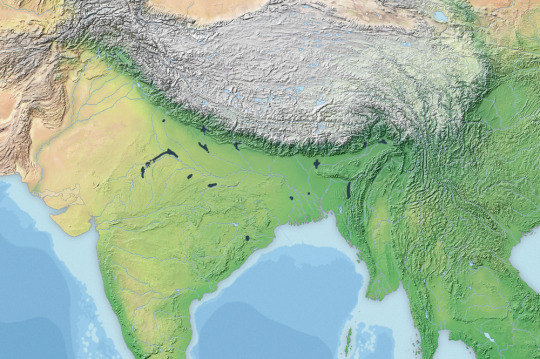

However when you look at how the range was meant to be like, then you see that they definitely reached the river deltas and coastal regions. So our image of gharials as this inland freshwater species is more based in circumstance than reality.
This becomes especially apparent once you begin to consider the paleobiogeography of gharials. Based on our current knowledge, gharials most likely originated somewhere in Eurasia or Africa, spreading from there across much of the eastern hemisphere and beyond (full disclosure I am not considering thoracosaurs to be gavialoids, more on that can of worms later maybe). Anywho, phylogenetic analysis and the fossil record both suggest that gharials then crossed oceans and settled South America sometime prior to or during the Miocene, where they diversified and gave rise to the gryposuchines. Some species even remained saltwater species, such as Piscogavialis, which lived in the coastal waters of Peru.
Although gryposuchines were once thought to be a distinct subfamily of gharial, recent research suggests that they were but an evolutionary stepping stone, with some South American form once again crossing the Pacific and settling down in Asia where the much more basal "tomistomines" or false gharials (a misnomer) still resided. And while the gryposuchines of South America went extinct, those that returned to Asia survived and eventually gave rise to the Indian Gharial of today.
Left: A cladogram showing the relationship between Gryposuchinae and modern gharials
Right: Piscogavialis swimming overhead some marine sloths of the genus Thalassocnus by @knuppitalism-with-ue


So ultimately, seeing a gharial in saltwater is much less bizarre than one would initially think, its just that habitat destruction and overhunting have largely pushed these gorgeous reptiles further inland and to the brink of extinction.
#gharial#indian gharial#gavialis gangeticus#gavialidae#news#croc#crocodilia#crocodile#india#herpetology#gavialinae#gryposuchinae#piscogavialis#some paleontology#palaeoblr
244 notes
·
View notes
Text
Wet Beast Wednesday: Adélie penguin
I previously covered the world's most famous penguin, the emperor. Today I'll be covering its less famous neighbor, the Adélie penguin. While being much smaller than the emperors, Adélie penguins are just as charismatic and highly ecologically important. They were named after the wife of the explorer who first described the species. Let's see if that was romantic or a mistake.

(Image: an Adélie penguin standing on a rock and facing the camera. It is a bird standing upright with flipper-like wings and webbed feet. The belly is white while the head and back are black. There are white rings around the eyes. End ID)
The Adélie penguin (Pygoscelis adeliae) looks like a penguin. Like picture a generic penguin in your mind and it'll probably look like an Adélie. They are flightless birds that stand upright, a posture that seems to be unique to penguins. They have countershading, with a black back and white underbelly. The most distinctive feature of an Adélie penguin is the white ring around its eyes. As with other penguins, Adélie penguin wings have adapted into flippers that enable powerful and graceful swimming but renders them flightless. Adélies reach a height of 73 cm (29 in) and a weight between 3.8 and 8.2 kg (8.4 to 18.1 lbs). The primary difference between males and females is that males are significantly heavier than females of the same size. As with most penguin species, it can be difficult to tell males and females apart without examining them. Adélie penguin feces and nasal discharge has been noted to be high in salt, the result of living in a very saline environment. By ingesting salt and nitrogenous substances in the sea and excreting them on land, the penguins help hasten the movement of nutrients from sea to land. This makes the penguins highly important to the antarctic ecosystem.

(Image: an Adélie penguin seen from the side as it walks over snow in a very dapper pose. End ID)
Adélie penguins are are one of the two penguin species to inhabit Antarctica itself, the other being the emperor penguin. They also share the many antarctic islands with multiple other penguin species and are rarely found as far north and Australia, Aotearoa/New Zealand, and South America. The penguins spend most of their time out on the pack ice, hunting for food to build up the layer of protective subcutaneous fat that helps keep them warm. Adélie penguins can be found hundreds if not thousands of kilometers from shore as long as there is access to the sea and ice flows to rest on. As the ice extends hundreds to thousands of kilometers in winter and retracts during the summer, the penguins will be on the move to retain access to the water. A penguin can migrate up to 13,000 km (8,100 mi) every year to retain access to both ocean and sea ice. They hunt and forage underwater, with a diet consisting primarily of krill, fish, squid, and jellyfish. Chemical analysis of shell fossils has revealed a change in diet from primarily fish based to primarily krill based around 200 years ago. It is believed that this change in diet was due to whaling diminishing the local baleen whale population, which was the primary krill predator. This resulted in a population boom of krill that the penguins took advantage of. It is very cool to me that you can tell what diet animals from thousands of years ago analyzing ancient eggshell remnants. Adélie penguins swim at around 8 km/h (5 mph) and can leap 30 meters out of the water to reach ice flows.

(Image: a group of Adélie penguins leaping off of ice and into the water. End ID)
Adélie penguins are noted to be very curious and fearless on land. They have no land predators and therefore have no predation response on land. Antarctic explorers have recorded that Adélie penguins would walk right up to charging and barking dogs without fear and quickly get eaten. They have been called boisterous by explorers and have been seen challenging much larger creatures to fights over space. During the filming of the BBC Earth documentary Spy in the Snow, the filmmakers caught footage of an Adélie penguin deliberatly protecting a group of emperor penguin chicks from a southern giant petrel who was hunting them. Despite the petrel's threat and the chicks being of a different species, the Adélie put itself between the predator and prey and repeatedly charged the petrel (which occasionally hunt adult Adélies) until it gave up and left. Adélies are not always as nice to each other. They will fight each other, especially during breeding season. Adélies are known to be reluctant to enter the water if they can't see another penguin swimming safely. They will gather in groups on the edge of the ice until one penguin gets pushed in. If that penguin doesn't get attacked by a predator, the rest will join.

(Image: a group of Adélie penguins being examined by a scientists sitting on the ground in a red coat and black pants. The group includes adults and chicks. The penguins show no fear of the scientist and some appear to be examining them. End ID)
Mating season lasts between October and February. During mating season, the penguins gather in rocky areas with no ice covering. The males gather piles of pebbles which will become nests. Males will try to steal pebbles from each other, which can led to fights. Once his pile is complete, the male will stand on top of it and begin a display involving pointing his beak up, vibrating his chest, and flapping his wings. A female who is wooed by his display will approach and bow, which he will then reciprocate. The male then shapes the nest into a pit and lets the female lay down in it. The male stands on the female's back to mate and they will rub beaks together while doing so. Adélie penguins are serially monogamous. They will form mated pairs during mating season, but will usually not pair off with the same penguin next season. On the other hand, Adélie penguins have been suggested to engage in prostitution. Males have been known to mate with females they are not paired off with, after which the female will take some of the stones from his nest. The reasons for this behavior is not clear and calling it prostitution may be applying human ideas to non-analogous animal behavior. Females may be examining males as potential backup mates should hers die. The male allowing the female to take some stones may also be an advantageous trait as if she does lay his eggs, having better stones will give them a better chance of surviving with him not there. Adélie penguins are notorious for their aggressive sexual behavior. Males will attempt to forcibly mate with females (possibly as a result of mistaking her bending over as a mating bow) and males without partners will attempt to mate with such things as chicks, dead penguins, and the ground. During mating season, males accumulate the hormone corticosterone in their systems. This hormone increases aggressiveness and sexual activity in birds and is likely why males who can't attract a mate will attempt to mate with anything they can.
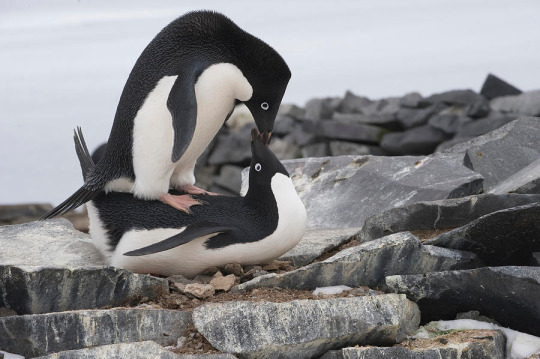
(Image: two Adélie penguins mating. The male is standing on top of the (presumably) female, who is lying stomach-down on the ground. The male's head is bend down and the female's head is bent up so their beaks touch. End ID)
After mating, the female will lay two eggs, the second a few days after the first. If one egg is lost soon after being laid, a third may me produced to replace it. The second egg is usually smaller then the first so they will still hatch around the same time. The father and mother share share incubation duties. One parent will sit on the eggs to warm them while the other parent returns to the sea to feed. The incubating parent will not leave the nest during this time. They do not eat while incubating and will projectile defecate to keep feces away from the nest. Shifts change every 7-10 days, allowing both parents to eat while keeping the eggs incubated. When both parents are at the nest, they will perform a mutual display involving waving their heads while calling out and bowing to each other. The eggs hatch after 32 to 34 days and the chicks will remain with their parents for another 22 or so days. During this time, the parents will take shifts guarding the chick and returning to the ocean to feed. The chicks are fed regurgitated, partially-digested food. Mothers who have lost their chicks have been known to try to steal chicks from other parents. After the 22 days, the parents abandon their chicks and return to sea. The chicks gather together in groups called crèches for mutual protection from predators. They must subsist on fat stores for another 30 to 40 days before developing their adult plumage and setting out to sea.
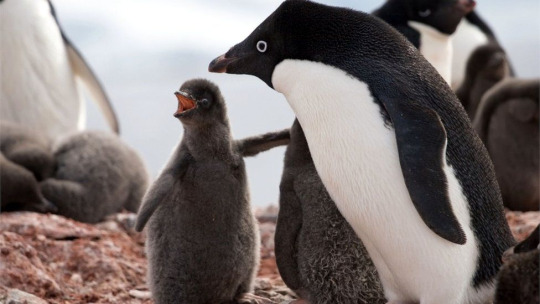
(Image: a group of Adélie penguins with a focus on a parent and a chick. The chicks are smaller than the parent and are covered in gray, fluffy down. End ID)
One of the earliest texts on Adélie penguin behavior came from the journal of the explorer George Murray Levick in 1911-12. He described the sexual behavior of the penguins but the result was considered too explicit and immoral to be publiched with the rest of the expedition's notes. As a result, Levick's noted were not discovered and published until 2012. One of the things in the notes that resulted in them being denied publication was the description of homosexual behavior. That's right, this is a surprise pride post. Despite what many conservatives would like you to believe, homosexual behavior is very common in the animal kingdom. Penguins are seemingly especially known for this behavior. While initial reports suggested that Adélies would accidentally mate with other males as a result of mistaken identity, this have been proven to not be the case every time. Male Adélies have been seen taking turns copulating with each other, which means they definitely realize the other is male. Similar behavior has been seen in other penguins. Famously, a male/male pair of chinstrap penguins (a close relative of the Adélies) named Roy and Silo in New York City's Central Park Zoo successfully fostered an egg and hatched a female chick named Tango, who also went on to bond with another female penguin. Multiple other species have also been know to form same-sex bonds in captivity (wild behavior being harder to study) with many even building nests and using round stones in place of eggs. Same-sex pairs have been known to bond with each other year after year when other penguins will chose different mates each year. Multiple zoos will let same-sex penguin pairs to foster eggs.
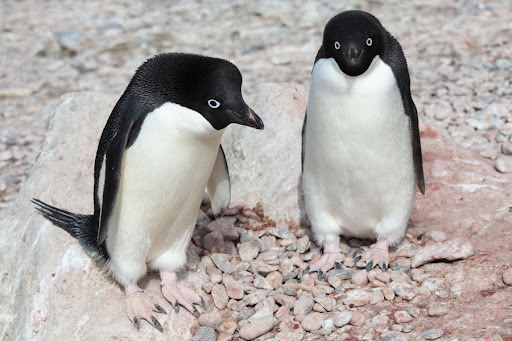
(Image: two penguins standing among a pile of pebbles. End ID)
Levick's notes on homosexual behavior in the Adélie penguins described them as deviant and disgusting. I bring this up because it leads me to a point I want to discuss. It is very important to not judge animals by human moral standards. Study of homosexual behavior in animals has been distorted and repressed by generations of scientists operating under an Abrahamic religious worldview where homosexuality is considered a crime against nature. In that worldview, it would not be possible for animals to be homosexual because now could nature commit a crime against nature? Thus, the use of rationalizations, deceptions, and cover-ups by scientists operating under that worldview. When the facts conflicted with their beliefs, they chose their beliefs. This is not the only time this has happened. Back in the early days of paleontology, famous paleontologists such as Sir Richard Owen discovered that theropod dinosaurs had similar traits to birds and that dinosaurs were not the slow, lumbering, lizard-like animals they were initially assumed to be, but highly developed, powerful animals. This conflicted with their pre-conceived religious beliefs in Biblical creationism where all species were created as they were and did not evolve and that modern species must be the better versions of past species as God wouldn't replace something powerful like a triceratops with something less powerful like a cow. These early paleontologists covered up and denied evidence that went against their beliefs and in doing so, set back the fields of paleontology and evolution in ways we are still trying to fully recover from. Failure to separate our moral standards from animal behavior is important to studying animals for the same reasons that those early paleontologists failing to separate the evidence from their religious beliefs was. I have heard popular animal Youtubers insult animals like Adélie penguins and dolphins in exactly the same way Levic did because of their behavior when mating. Those kinds of attitudes are thing we need to get over when studying nature. Nature is under no obligation to conform to the many and varied moral standards of humans and we need to recognize that. This doesn't just apply to people who disapprove of animal behavior. You will notice that I never called any of the penguins "gay" or anything similar in the above passage. That was deliberate and it's not because "I'm a homophobe trying to to deny that gayness exists in nature" or anything like that. That would be a pretty fucking hypocritical thing for me, a trans lesbian, to believe. I don't think it's fair or intellectually honest ascribe human descriptions of behavior and psychology to nonhuman animals. We have very different psychological makeups from penguins and the definitions we use simply may not apply to them. Similarly, penguin mental constructs or concepts wouldn't apply to us, at least not in the same way. Nobody can read a penguin's mind and nobody can Animorph into a penguin to experience its psychology first hand. If Roy and Silo were able to talk, would they identify themselves as gay? Would the modern, western idea of gay even make sense to a penguin? I have no idea and neither does anyone else. And I think applying labels for human concepts like being gay that may or may not apply to an animal risks introducing bias to our understanding that can produce mistakes and misunderstanding about that animal's behavior. This is true whether you think being gay is good (like me and hopefully everyone reading this) or bad (like Levick did).

Oops, what's this doing here? (Image: an old-fashioned soapbox. End ID)
Adélie penguins are classified as Least Concern by the IUCN. This does not mean they are not facing challenges. The loss of sea ice due to global warming has reduced the available habitat and has seen population drops. Chick survival rates have also been decreasing. In addition, as of 2024, a mass die-off of over 500 birds was discovered and is being attributed to H5N1 bird flue spread from South America. This strain has also been found in local skuas, which could act as vectors to spread to to other species and populations. This situation is currently under investigations and we currently can't predict where it will lead.
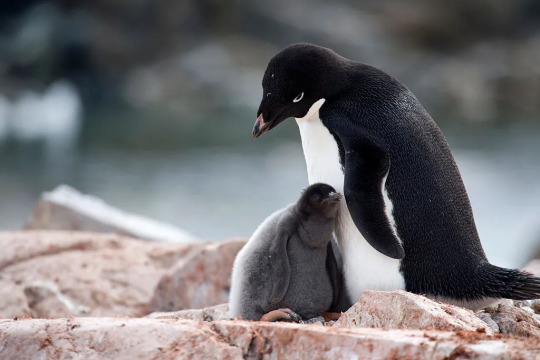
(Image: an Adélie chick nuzzling its parent's belly. End ID)
#wet beast wednesday#adelie penguin#adélie penguin#penguin#bird#antarctica#homosexual behavior in animals#pride month#pride#marine biology#biology#zoology#ecology#animal facts#ornithology#informative#educational#image described
70 notes
·
View notes
Text
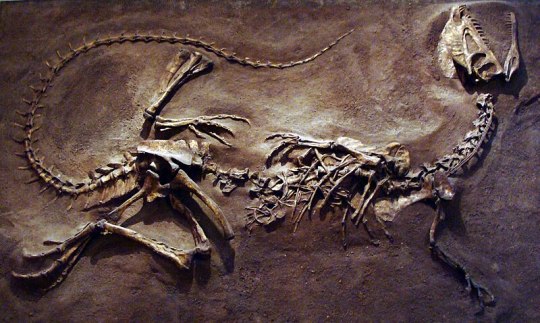
Name: Dilophosaurus wetherilli
Debut: Real Life, Circa The Early Jurassic (roughly 280 million years ago)
Hi I'm gonna talk about my favorite dinosaur now and you're gonna like it! Or maybe you won't, I don't know you! But y'know what I do know? Dilophosaurus!!! It's my best friend. They named it after the fact that it's got two (di) crests (lopho) on its head and also it's a reptile (saurus). A big reptile at that! In fact, it was the largest known animal of its time to walk the land in North America, and was almost certainly the apex predator of its environment, the Kayenta Formation (located across several of what are now the South-Western United States).

As you can see, this size chart demonstrates that the largest specimen discovered was about 7 meters (23 feet) long; no Tyrannosaurus rex, mind you, but still far larger than... some popular depictions might lead you to believe.
Also contrary to what some popular depictions might lead you to believe, Dilophosaurus would not have required the use of various biological mechanisms such as, for instance, retractable neck frills or venom-spitting to take down its prey; mechanisms which, mind you, are exclusively seen in animals as methods of self-defense, and would therefore only serve to scare away potential prey items.
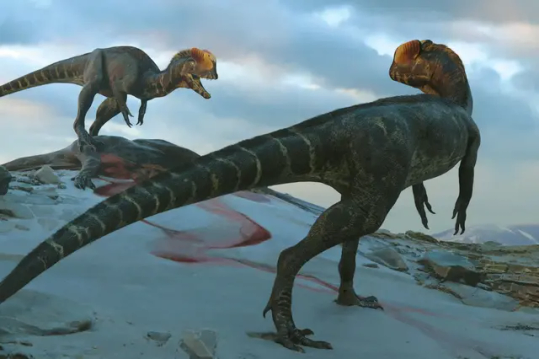
Speaking of prey items, this stunning piece by Chase Stone depicts a pair of Dilophosaurus as having just brought down a prosauropod (a name for early sauropod relatives). Dilophosaurus did in fact live alongside at least one prosauropod, Sarahsaurus, the Holotype specimen of which bears tooth marks very likely left by a certain two-crested culprit! On that note I want to address another prevalent misconception in regards to life reconstructions of this animal...
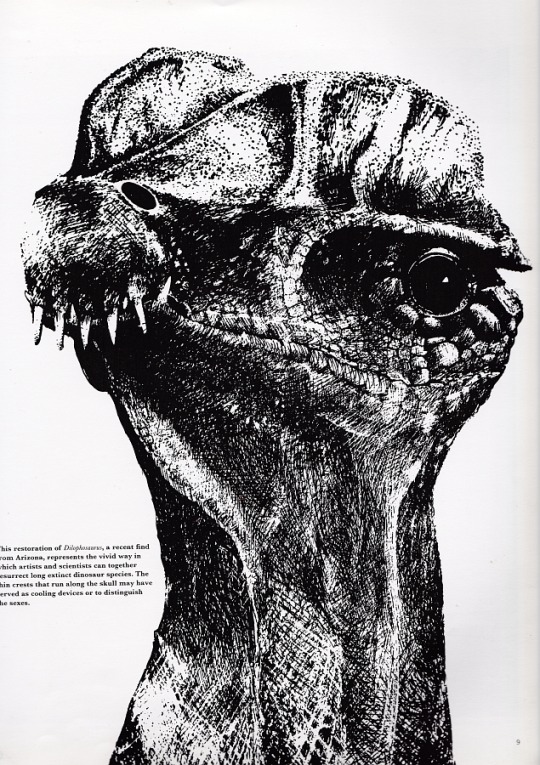
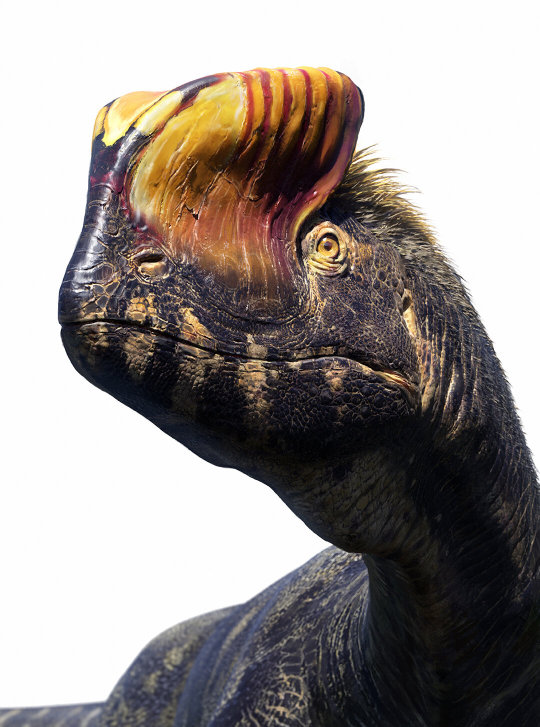
On the left we have a (frankly hilariously sock-puppet-like) restoration by a sadly unknown artist, and on the right is another absolutely breathtaking rendering by Chase Stone. As you can pretty clearly see, the way the crests (among other things) are restored is very different between the two! For a long time, the crests were restored as seen on the left: very thin, and with a little protrusion jutting out of the back. This is due to something called shrink-wrapping, a trend in paleoart exemplified by the omission of tissues such as muscle or fat when reconstructing the animal, leading to much of the skeleton being visible through the skin, particularly in the case of the skull.
Stone's restoration, on the other hand, wraps the skull in a much more naturalistic-looking amount of soft tissue, and completely envelops both crests in a keratinous structure, much like the casque of a cassowary or a hornbill (in fact I believe the coloration is actually referenced specifically from a knobbed hornbill's beak).
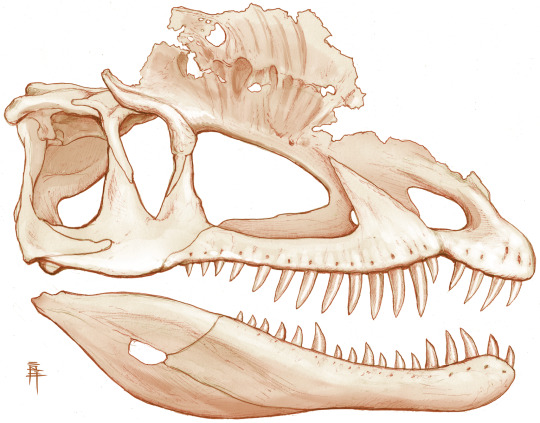
This is due to the fact that the crests were likely a kind of bony core which would have supported a larger keratinous structure as is to be expected of... sigh... horny structures such as this. Stop smiling. Don't you know there's no fun allowed when you're learning about things? That's what school taught me, anyway. Ahem. As I was saying, the original shape of the crest was extrapolated from incomplete remains, which you can see a restored illustration of above.
Also worth noting is the inclusion of a thin, fluffy covering of feathers along the head, neck, and back of Stone's restoration. This is entirely plausible, as the current consensus is that dinosaurs and their close relatives, pterosaurs, were descended from a fluffy common ancestor due to the fluffy-feathery coverings seen in both groups being found to be basically the same stuff!

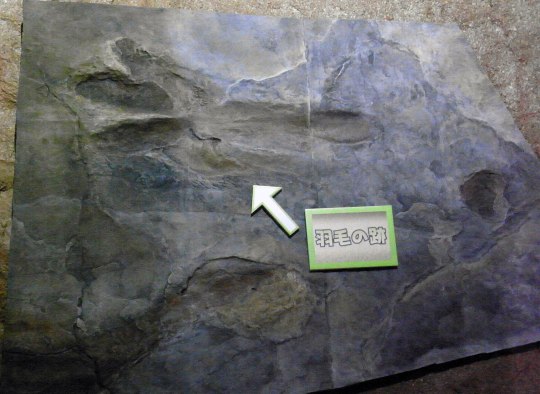
I could go on about so many things, like how tremendously fucked up and addled with tumors and infections the Holotype specimen was, or how we have a trace fossil which seems to preserve a Dilophosaurus sitting down in the mud like a big dumb bird, complete with an impression of its butt, but I trust that if these things pique your interest enough, you'll seek them out on your own time. Just remember not to have fun, because as we all know, fun is the one thing learning should never be.
61 notes
·
View notes
Note
What are the advantages of fore and aft rigs vs square rigs?
Hi,
The fore and aft rig, or schooner rig, required only a small crew, and was generally used in the coastal and fishing trades. Ships with this rig could point higher into the wind and were usually more maneuverable when working in the changing winds along the coast. The rig was not limited to coastal schooners, and big fore-and-afters could be seen plying across the Western Ocean bound for European ports, the West Indies, or South America.
The square rig was normally an offshore rig used by vessels making long ocean passages and taking advantage of the prevailing wind and current patterns of the globe. These ships varied in size from the small handy brigantines and brigs of a couple of hundred tons to the great full rigged ships and barques of over two thousand tons. The square rig was also seen in the coastal trade, where brigs plied their trade up and down the eastern seaboard.
I hope it will help you and have a nice day
56 notes
·
View notes
Note
The Touring Data account on Twitter has posted updated numbers for Louis’ shows in Latin America, and it has caused a bit of fandom drama because the attendance was lower than expected. Some fans claim that the figures for the Mexico City show are wrong and the concert was attended by 67,000 people and that this has been confirmed by Louis’ team. I’m pretty sceptical about this claim because I haven’t seen any evidence of this apart from a few newspaper articles, and they seem to have relied on info from Louis fan update accounts. The Touring Data account itself also tends to be reliable because it just reports numbers from Pollstar.
Do you have any thoughts on this or about the figures in general? I’m no expert on touring but it seems to me like Louis’ team might have overestimated the size of the venues needed for some of the shows. But maybe it just makes more sense economically to play one show in a big venue rather than two shows in a smaller venue?
https://x.com/touringdata/status/1831090091294617979
I'm very glad that this sort of fandom drama only gets to me through anons. I really appreciate that you've explained so fully what's going on and linked to sources, because otherwise I'd be super lost.
My main thought is that current fandom treats worrying about this sort of thing as standard fandom practice. And it's not, or it doesn't have to be. I think its main function is to make fandom a more anxious experience - and I would strongly advocate for people turning their fandom towards the bits that bring them joy.
What that means is not talking about the data directly, but instead talking about the meta question of the meaning people are giving to the data. (If I was going to talk about the data directly it would be giving it meaning by comparing to what we knew about ticket sales at his last Latin American tour, but I don't care enough to try and do that).
I can come up with two explanations for why fans might give the questions of how many tickets are sold at a local venue so much weight - one is basically economics and the other is very fucked up ideas about validity.
There are two reason that you might be concerned about economics - one is concern for the artist (which I think it's good practice to try and not being too concerned about artist's financial position. They're wealthy and they're making money off other people's labour. If you want to be concerned about the finances of anyone involved, be concerned about the finances of people who make merch), and other is concern for whether or not they'll come back.
The problem is that fandom discussion is based on a complete lack of curiosity (that crosses over into willful ignorance) about how touring works. From the way fandom talked about it, you'd think an artist and their team selected and booked the venues in each case - took on all of the risk and got all of the reward. But that's only true of independent tours and most tours aren't independent. Promoters often offer a guarantee (that's the minimum an artist is paid) and a bonus for a sell-out - and what happens to the amounts in between is up for negotiation. The artist meets all of their touring expenses out of their cut (so that's transport and people and equipment that travels). So the economics of a tour can really vary. Some tours are budgeted around selling-out - others aren't. What will make a tour work for both an artist and a promoter is mostly completely opaque to the public.
It's possible that the promoter pitched larger venues than was wise - there have been indications that that's been happening since the first wave of post-pandemic concert enthusiasm. But it's just as possible that the promoter owned these venues and it was better to have an act in them than not. We certainly don't know from these figures that Louis' tour underperformed expectations, or who is carrying the cost of it is unknown.
According to that data, Louis sold around 130,000 tickets in South America (back of the envelope adding to the near 1000 - may be a bit off). If he'd sold double that it would have made him more likely to come back, or play more venues. But I don't think there's any reason to panic. Lots of artists come to New Zealand, don't sell out their venue and come back. And currency strength has a lot to do with who does and doesn't come here.
There could be a lot of good conversation on the levels venues sell at where fans talked about their own experiences. Not just the question of will they come to me (although that's very pertinent to me). But what sort of venues would you like to see an artist in? Might ticket prices go down? But that's never the tone of the conversation.
Instead an assumption in all this is that validity is scarce and measurable. I think it's really important to say that this is not true. It matters to some business people whether an artist sold 60,000 tickets or 30,000. But it doesn't really matter to anyone else.
And buying into a worldview that it does matter, will only harm fans mental health.
#That last bit is the most important to me#because I'm convinced that people turn to this sort of understanding of fandom#Because of the way they feel about themselves#with artists as a sort of proxy#But it'll only end up making people feel worse#Because it's a trap#neither you nor the people you identify with can ever be validated this way#(as I hope Harry is working on with his therapist)
13 notes
·
View notes
Text
not to sound like a 13 year old but i've got particular beef with the idea of the districts of panem lining up with the geography of north america like i Get it i've seen the maps i understand the intent of the author and how it makes sense culturally but deep down inside it just feels wrong to me and i can't do it.
it's like u say "nuclear war wiped out most of the planet" and that's supposed to make me accept that the extraordinarily strong culture of american statehood just collapsed into 12 regional districts like that?? fine i guess if we account for a long long gap of time between nuclear war and the original inception of panem. maybe.
but also. the way it's described clearly implies each district is able to gather its entire population in one square on one day for reaping day and honestly strongly implies that each district + the capitol are comprised of only one urban center (of varying sizes) each implying that the area of these districts Has to be so much fucking smaller than it appears on any of the maps that float around. where is all the empty space. the north american landscape is Huge even with the amount of coastline taken away due to oceans rising and that space is like. a huge huge factor in living here. there is not that sense of geographic scale and empty spaces between districts except like. the forests outside of 12 (speaking of like. katniss is able to walk the entire fence by herself in less than a day to check for weak points. these districts are small. even if 12 is smaller than say 11. that's ridiculously tiny all of these districts have to be small and definitely not entire regions of the continental united states)
also many many other ppl have made this point lmao but. the foreign policy of panem is not mentioned except for those vague notions of a nuclear war in the distant past and it is just. stretching imagination beyond belief to imagine that if panem truly is north america president snow literally is only concerned with domestic policy even the most isolated authoritarian regimes on earth today still have to deal with foreign policy on some level (and north america is lucky to have near self sufficiency w resources bc oil and such but. we do not have rare earth metals to sustain the technology level of panem. i'd be willing to discuss the hypothetical that panem has zero computers and batteries it's not impossible but.)
all in all it's very clear that culture/resources of 12 is inspired by and modeled on appalachia and that the more extreme repression/resources of 11 are inspired by and modeled on agriculture and racist government styles of the deep south etc etc and that makes sense bc like. suzanne collins is deeply entrenched in american culture and so is the hunger games as a series and she absolutely nails the culture and political connections bc it's an extremely adept commentary on modern american society but. the geography just doesn't make sense and raises too many questions and i wish you all would accept like me that it takes place in a fantasy land of pure allegory
#the handmaid's tale version of america and the uglies version of america i do accept.#bc they both have clear ties to the past Before dystopia got put in place and have govt's concerned w foreign policy!!!#and in the uglies series for example there is a sense of the geographic scale of the north american continent despite the current populatio#being packed into self sufficient urban centers#plus!! other countries!!!!!!!!!!!!!!!! they go to japan!#the hunger games
22 notes
·
View notes
Text

Solar Eclipse Info, 2024
Hey, over the last few weeks I've seen a lot of curiosity about the upcoming solar eclipse. Here's a quick roundup of some common questions and answers that might help!
1. Da fuk is a solar eclipse, anyway?
The Moon goes in front of the Sun. Because they look about the same size from Earth - a very cool coincidence! - when they line up just right the entire disk of the Sun gets covered up, making it a total eclipse. On April 8, 2024, this only happens in a narrow band of North America: a thin ribbon stretching from Mexico to Canada, traced out by the Moon's shadow.
In most places, the Moon will be a bit too high or too low to cover the Sun right; here folks will only get to see a partial eclipse. Partial eclipses are kinda cool, but nothing like a total eclipse.
2. Hey – If the Sun is covered, won’t it get dark?
Yes and no. The Sun is stupidly bright, so even when most of it's covered, daylight doesn't look super different. Even during the last fifteen minutes or so before it's 100% covered, the light only gradually begins to dim. It's only once the Sun is entirely covered – what we call "totality" – that it really gets dark. (Not dark like midnight, but about as dark as twilight.) Also, because the Moon's shadow is constantly moving, this bit of darkness only lasts a few minutes, depending on where exactly you are.
3. Why are people telling me to wear eclipse glasses? Is it some stupid cash grab? Or are eclipses weirdly dangerous?
Eclipses themselves are not dangerous. The Sun is, though – because like I said, it's stupidly bright! The reason why scientists warn people about hurting their eyes during an eclipse is because that’s basically the only time millions of people will try staring directly into a giant dazzling ball of gas.
So YES - anytime even a tiny bit of the Sun is visible, use eclipse glasses or some other verified, proper filter to save your poor retinas. They’re the only ones you have! Only if and when the Sun is COMPLETELY covered should you take a look without a filter.
NOTE: Filters are even more necessary if you're using binoculars or a telescope! These things work by collecting and concentrating light, so when pointed at the Sun without a filter, the beam of light coming out of the eyepieces can literally melt holes through plastic. I've seen it myself. So please… use a dang filter, okay?
4. Da heck is that white stuff around the sun in the pictures? Do I need glasses to look at THAT?
That's the corona – the Sun's searingly hot outer atmosphere. Because the Sun is stupidly bright (besides being a deadly laser) the corona is usually invisible to us. So, yep – total solar eclipses are the only time you and I ordinarily get to see it!
And nope, the corona is pretty dim and totally safe to look at without glasses. Just DON'T get so focused staring at it that you forget to put your eclipse glasses back on when totality ends!
5. How rare are these things, anyway? And why?
As it moves through the sky, the Moon circles past the Sun literally every 29.5 days – it's just that usually it's too high or low to cover even a bit of it. Globally, solar eclipses do happen pretty frequently: about every 18 months on average. But because the Earth is a big place, they might occur anywhere: the south Pacific, Africa, even Antarctica. On top of that, the odds that you specifically will be somewhere in that thin band of totality is pretty darn rare. As far as North America goes, the last total solar eclipse was nearly seven years ago, in 2017. For the next one in North America? You'll have to wait until 2045.
6. Why are people so excited?
As someone who got to experience totality in 2017 (that's my own pic above), it's tough to explain. Many people, even folks who aren't particularly spiritual, have likened totality to a religious experience. There's something chillingly cool about standing still and feeling the sun slowly dim as the Moon's shadow sweeps toward you. It's a cosmic motion as inexorable as fate, and no one – not you, not the pope, not even Bruce Willis – can stop it.
Once totality hits, the temperature typically drops a few degrees. Wind sometimes picks up or dies down because of the temperature drop. Birds and other animals freak the heck out. The brighter stars come out, midday be damned. All around the horizon glows a 360-degree "sunset"… while overhead it's like the Sun has died and left us puny humanoids staring up open-mouthed at its ghostly shell.
THAT's why totality is a big deal. And why I, along with literally millions of others, will try my level best to go see it. All the while hoping like heck that it's not cloudy.
–––
To read a more in-depth and super-useful guide, check out NASA's official site. Great American Eclipse also has a lot of sweet resources and maps. And feel free to reply with any other questions!
#total solar eclipse#eclipse 2024#solar eclipse#different from what I usually post but so what#i like star stuff okay?
19 notes
·
View notes
Text
HARRY'S QUEST
Disclaimer: I don't have a Shuar dictionary or grammar, so I had to make up the language spoken by the tribespeople, but I have tried to make it similar to the small sample that I've seen on YouTube. Also, fair warning: since the story is set in Ecuador, there's quite a bit of Spanish dialogue, untranslated -- Harold doesn't know what's being said, so why should you? Lol
Tw: death, murder by execution
Beej did a double take when he got to the office and saw the new arrival. The guy was a good eight or ten inches taller than the demon, and he was wearing a safari jacket and pants with the cuffs tucked into a pair of black hiking boots -- and he was carrying a hunting rifle.
But it wasn't the guy's height, or clothing, or even the firearm that took Beej by surprise -- it was the guy's head. It was tiny -- about a quarter the size it should've been. The black hair had been pulled up into a severe topknot and tied with a red cord, and the guy's lips had been sewn shut.
"Holy crap! " Beej exclaimed. "What the fuck happened to you, pal?"
The guy looked at Beej with bulging eyes -- they were normal sized and therefore too large for their sockets -- and tried to speak, but all that came out was, "Mmm! M-mmm-mmmmmm-mm-mmmmmmmmm! "
"Sorry, buddy," Beej said, clapping him on the back. "I didn't quite get that. Anyway, whatever happened it looks like a pretty shitty way to die. Tough luck, pal. Well, I can't stick around -- I gotta get up to Florida for my next job. They just executed the guy who tried to assassinate Roosevelt -- name of Zangara. I'll see you around!"
*****
Harold J. Wilson III had been in Guayaquil a week before he managed to find someone who was willing to take him into the jungle.
He'd come to South America in search of a creature that would guarantee his name would live forever -- the mapinguari. Supposedly extinct for thousands of years, but there were rumours -- based on accounts by the local Indians -- that it was still alive in the deepest part of the Amazon. And he was determined to bag one and bring it back to the Smithsonian.
"Sí, señor," the guide, a short, stocky man in his fifties named Pedro Morales, said. "I know the jungle -- but it is not a safe place for un americano, especially a rich americano like yourself."
"I've been in plenty of dangerous places," Harold told him. "Congo, in search of the mokele-mbembe, for instance."
"Did you find it, this ... mokele-mbembe?"
Harold shook his head. "Unfortunately, no," he said. "But I'm sure I'll find the mapinguari. Now, will you guide me or not?"
Pedro looked at the American. He took a deep drag on his cigar, blew out the smoke and nodded. "One hundred American dollars."
Harold pretended to consider the amount for a moment, and then he smiled and held out his hand. "You have a deal."
Pedro grinned. "Muy bien," he said. "We should leave tomorrow, at dawn. Before the heat becomes unbearable, sí?"
*****
"Lawrence!"
Beej, startled, whirled around at the sound of Juno's voice. "Hi, Mom!" he said, panicked. He hurriedly tried to hide the files he was holding behind his back. "You, uh ... you got another pickup for me?"
"What are you doing with those files?" she asked, cigarette smoke billowing from the hole in her neck. She took another drag.
"Huh? Oh, you mean these files? I, uh ... I was just curious about the new guy ... how he died, that's all."
"Oh, but sweetie," Juno said, smiling, her voice gentle, "you don't know how to read very well." Then she looked at him contemptuously. "Hand them over!"
"Sorry, Mom," he replied, chastened, and gave her the files.
"Now get back to work, and no more screwing around! "
"Yes, Mom," Beej said in a voice that was barely above a whisper.
"I can't hear you! "
"Yes, Mom," he said again, louder this time.
Juno nodded. "That's better." She stuffed the files back in the drawer and limped away, the thump-slide, thump-slide of her footsteps loud in the sudden silence of the office.
Beej looked around. The others, who had no doubt been watching the exchange, quickly put their heads down to focus on their work.
Beej blinked back the tears and shuffled out of the Processing Department to his next assignment.
*****
The sun was just beginning to stretch its first rays over the rooftops when Harold was awakened by a knock on the door of his hotel room.
"Buenos dias, Señor Harold," Pedro said when the American opened the door. "Are you ready to leave?"
"Let's go," Harold replied with a nod. He grabbed his gear and followed the guide out to the waiting Jeep. He tossed his bags in the back and climbed into the passenger's seat as Pedro turned the ignition, and then they started off, down the dirt road towards the jungle.
"We will have to stop at San Ignacio and continue on foot from there," Pedro said. "No hay caminos en la selva."
Harold nodded -- he knew enough Spanish to understand what the other man had said. No roads in the jungle.
"This village -- San Ignacio -- how far is it?"
"Two hours, más o menos," came the reply. "We will stop for lunch, and then hike in."
"How will we know where to go?"
"A village elder, Tío Chako, says that he has seen the mapinguari when he was a young man," Pedro told him. "We will follow his directions." He looked at his passenger. "But that was many years ago, señor -- who can say if it will still be there?"
"I understand," Harold replied.
*****
In fact, the drive to the Otavalo village of San Ignacio took nearly three and a half hours, and by the time they reached the village the sun was already fiercely hot.
The guide stopped the Jeep in front of a small, single-storey house with whitewashed mud walls and a thatched roof. They got out of the vehicle, and Pedro knocked on the wooden door.
A moment later, it opened, and a wizened old man in a dingy tank top and baggy trousers looked out. "Hola," he said -- Harold saw that he was missing his lower front teeth. "¿Quién están ustedes?"
"Soy yo, Pedro. Y eso es Señor Harold, de los Estados Unidos."
"¿Un americano?" Tío Chako was incredulous. "¿Aquí?"
"Él quiere trover el mapinguari," Pedro explained.
Tío Chako shook his head. "¿El mapinguari? No, es demasiado peligroso -- los Jívaros ..."
"Lo sé, pero es un americano rico ... y tonto."
"Pedro, no es bueno -- irás al infierno por esto."
"¿Y él? Él quiere matar el espíritu de la selva por un trofeo." Pedro smiled. "El Santo Padre me perdonará, creo."
"What's going on?" Harold asked -- his Spanish wasn't good enough to follow the exchange between Pedro and Chako.
"We are just discussing the preliminaries, señor."
"Por favor, entran ustedes," the old man said.
"Gracias, tío," Pedro replied. To Harold he said, "Unfortunately, Tío Chako does not speak English -- I will interpret for you."
Harold looked around the abode. It appeared to have only two rooms -- the kitchen in which they were standing and another that was probably the bedroom. At the table, a woman who was almost as old as Chako sat peelig potatoes.
"Mi esposa, María," Chako said.
"¿Visitantes? ¿Por qué no me dijiste que teníamos compañía?" María asked.
"María, ¿te acuerdas de Pedro?" Chako said. "Y este es el señor Harold, un americano que está buscando al mapinguari."
María's eyebrows shot up in surprise, but she caught herself and said, "Bienvenido, Pedro. Y bienvenido, Señor Harold. ¿Se quedarán a almorzar?"
"Gracias, tía," Pedro replied. "Tenemos un largo viaje por delante."
*****
After a lunch of seco -- goat stew served with rice and plantain -- Pedro and Chako looked over a map of the region, discussing the most likely places to find the elusive mapinguari.
"Yo lo ve aquí," Chako said, pointing to a spot where the Rio Negro looped around like a noose. "Pero no sé si eras allá esos días."
"Lo entiendo," Pedro replied. "¿Y los Jívaros? ¿Donde es su territorio?"
"Casi todo el este es el territorio de ellos." He looked at Pedro. "Rezaré a San Cristóbal para que todos regresen sanos y salvos."
*****
"You know," Beej said, "I don't think I've ever seen anyone else who had their head shrunk before -- how'd it happen?"
The guy looked at the demon with his bulging eyes and drew a thumb across his throat.
"Yeah," Beej said with a nod. "That makes sense -- I mean, it'd be kinda difficult to shrink just your head if it was still attached, right?" He elbowed the guy in the ribs. "But how come it's attached now? I've seen others who've lost their heads, and they're always carrying them, you know?"
"M-mmmm-mmmm," came the response.
"Yeah, of course you don't know. Anyway, I'm wondering how they did it -- shrunk your head, I mean. But I guess you don't know that, either -- you were already dead."
The guy nodded.
Just then the door to Juno's office opened. Beej leapt to his feet. "Well, nice talkin' to you, pal -- see you!" And he scurried away before his mother could see him.
*****
It was an thirteen day trek through the jungle to get to the area where Tío Chako said that he had seen the creature. Harold had long since run out of citronella oil, and he was covered in mosquito bites, but that wasn't the worst of it -- every night was spent pulling leeches, ticks and other bloodsuckers off his exposed skin. He would've liked to bathe more often in one of the rivers, but he didn't dare -- the waters were home to flesh-eating piranhas, as well as anacondas and caimans. And other, more fearsome things.
"Candiru," Pedro told him. "It is a tiny, tiny fish that smells the piss and swims up your ..." He motioned to his crotch. "¿Entiende?"
Harold nodded grimly.
*****
At long last, Pedro set down his pack and said, "Es el lugar."
Harold looked around. It seemed exactly the same as the rest of the jungle -- trees and plants growing in riotous profusion in the eternal twilight, the silence occasionally punctured by the squawk of a bird or the screech of a monkey, or the sound of something larger making its way through the undergrowth. It felt like he and Pedro were the only two people in the entire world -- Harold would have been unsettled if he weren't so drenched and weary.
They set up camp as they had every night for the past two weeks, and Pedro built a fire with sticks that he gathered, smearing them with pitch from a rubber tree -- the smell of broiling latex was terrible, but it allowed the damp wood to burn.
Sunset comes quickly in the depths of the jungle. They had just finished their supper -- boiled mote corn and ch'arqui made from llama meat -- when it arrived and they were plunged into darkness. As always, the jungle came alive then with the sounds of nocturnal wildlife.
"You should sleep, señor" Pedro said. "I will take first watch."
Harold nodded and gladly slipped into the tent. He lifted the mosquito netting strung over his hammock and settled in.
He'd just drifted off when Pedro shook him roughly. "Señor," the guide whispered urgently. "Señor, wake up! I think I hear the mapinguari!"
Harold sat up, instantly awake, and rolled out of the hammock. "Where?" he asked. "Are you sure?"
"I can smell it -- can you not?"
Harold sniffed the air -- a rancid odour, like that of soured compost, filled his nostrils. "Let's go," he said, grabbing his rifle.
The two men exited the tent and headed in the direction of the odour, training their flashlights on the ground in front of them.
A few minutes later they heard a deep snuffling sound. They raised their flashlight beams ...
The mapinguari was scratching itself against an acacia. Harold gasped as it turned its head to look at them -- the beast had to be eight feet tall, with long, shaggy, reddish-brown fur. The three claws on each of its front paws were massive, easily capable of shredding a tree. The beast had tiny eyes and ears, and a flexible muzzle that reminded Harold of a tapir's. He caught a glimpse of the massive tail trailing on the ground behind it -- thickly muscled, like that of a kangaroo.
"I knew it!" Harold crowed. "It's a giant ground sloth!"
The creature made a low, rumbling noise that sounded for all the world like it was saying huuuhhhh?
"I've got you now!" Harold crowed as he raised his rifle and took aim. He pulled the trigger, and the sound of the weapon instantly caused a pandemonium of noise in the jungle as bird, bats, monkeys panicked and took flight. The mapinguari bellowed in pain as the bullet ripped into its flesh, and it turned toward the two men, its powerful forearms raised threateningly.
It lunged at them, roaring in confused fury. Pedro screamed and fled. Harold readied himself to take another shot, but the huge beast was too close. He dropped the rifle and ran, stumbling over tree roots, desperate to avoid those massive claws.
The beast was gaining on him -- he could practically feel its hot breath on the back of his neck. "Shit shit shit shit shit! " he wheezed.
He took a tumble then, rolling down a short embankment into the river. "SHIT! " he yelled, and scrambled back onto the bank before something in the water got him.
He trained the beam of his flashlight upwards, grateful that he'd managed to hold onto it.
The mapinguari was looming over him, looking down at Harold. Its tiny eyes looked ... almost sad. Harold felt a twinge of regret for having caused it pain.
"I-I'm sorry," he said softly. And bowed his head, ready to accept whatever punishment the beast -- this jungle god -- saw fit to mete out.
But then he heard voices -- human voices shouting in a language he didn't recognise. The mapinguari heard them, too, and it calmly settled back down on all fours, turned and ambled off into the jungle.
"Hey!" Harold called. "Hey! Over here!"
Within seconds he was surrounded by a dozen or so spear-carrying warriors, wearing feather headbands, beaded bandoliers and red face paint.
"Wiñámishi jṵna kimiijusiai!" one of the warriors shouted. "Jikanyi ústa kanimuistaiyi! Uukanta!"
"I'm .. I'm sorry," Harold said. "I don't understand --"
"Uukanta!" the warrior shouted again. "Uukanta!"
Three of their number hauled Harold to his feet, and they bound him, tying his hands together behind his back and fixing a noose around his neck.
"Iijintaiyi nan chanwaarka ujaantaiyi na! "
And they led him through the jungle.
*****
Beej couldn't get the shrunken-head guy out of his mind. Or more accurately, he couldn't get the question of how breathers could shrink somebody's head out of his mind. He could do it easily, of course -- but he was a demon.
He decided to go back in time to see for himself -- after all, the information could prove useful someday.
He looked around to make sure that no one was watching, and then he snapped his fingers.
Instantly he found himself in a village in the middle of the Amazon jungle. Fortunately, since he was invisible, his arrival went unnoticed by the inhabitants. But he didn't think they would've noticed him anyway -- there seemed to be some kind of celebration going on.
A crowd of people were circling a large bonfire, singing and shuffling to the beat of drums as the thin, high notes of a couple of flutes threaded through the air. He could smell roasting meat and vegetables, and his stomach grumbled.
"Looks like fun," he said to himself, and moved closer.
Off to the side he saw someone tied to a post -- he recognised him as his new buddy, the shrunken-head guy. Same clothes.
He continued to watch, glad that he'd arrived at the right place and time.
Beej didn't even think of intervening on the guy's behalf -- what the fuck did he care about saving a breather? Eventually every one of them died anyway.
At last the drumming and dancing ended -- just as the first rays of the sun began to paint the treetops with golden light.
The prisoner was cut down, and he crumpled to the ground, unconscious.
He was lifted up by several warriors and laid out spread eagle on a stone slab, his wrists and ankles tied to wooden posts. Then one of the warriors, strode up, a machete in his right hand. He raised the weapon high, and bellowed, "UKAIYIII!!!"
"AAAIYIIII!!!" the others shouted in response.
The warrior brought the wicked-looking blade down and severed the prisoner's head with one blow, and the women of the tribe began ululating in applause.
The executioner reached down and picked up the head by the hair, holding it aloft for all to see.
Beej was impressed -- it took some skill to sever a head with a single blow, even with a machete. Clearly this wasn't the warrior's first time.
The warrior gently handed the head to another man -- this guy was older, with grey hair. They exchanged a few words -- Beej heard them say muisak several times, and tsantsa. Two words he'd heard before. They meant "soul" and "shrunken head" in the Shuar language.
He nodded to himself.
Beej had heard of the Shuar, or Jívaro. Fearsome headhunters, they were famous for shrinking the heads of their enemies -- he didn't know if there were any other tribes that did that, though. Always wondered how they shrink the heads -- looks like today's the day I get to find out!
He followed the shaman into one of the thatched huts -- a large pot of water simmered over a fire in the middle of the room. The shaman picked up a knife with a blade of chipped flint, sat cross-legged on the floor beside the fire, and set to work, chanting as he did.
Beej squatted down beside him, still invisible, as he sliced into the back of the head, cutting the flesh from neck to crown, and carefully removed the flesh from the skull in a single piece. When he was done, he sewed the eyelids shut and forced three sharpened pegs through both lips.
The old man then took a baseball-sized sphere carved from wood and placed it inside the skin, and dropped it into the boiling water. He continued chanting, shaking a rattle made of shiny black seeds, as the de-boned head cooked.
This was going to take a while, Beej knew, so he headed outside to see what the tribe was going to do with the body. He was disappointed to see that they were burying it, rather than cooking and eating it. What a waste, he sighed. Ah, well -- can't have everything.
*****
A few hours later the shaman removed the head from the pot -- Beej was surprised to see that it had shrunk to about a third of its original size, and the skin was dark and rubbery.
The old man carefully turned the head inside out and began scraping the flesh and fat from the skin. Once it was completely clean he turned it rightside out again and sewed up the slit in the rear.
"Okaaay," Beej muttered.
With wooden tongs, the old man took several small rocks out of the fire and dropped them into the neck opening, followed by a few ladles of hot sand from the smaller pot.
"Why are you doing that?" Beej asked, knowing that the shaman couldn't hear him.
He watched, amazed, as the head shrank further, the skin contracting from the heat.
The shaman emptied the head and refilled it with more sand and rocks, holding more hot rocks against the outside to shape the features. This process was repeated several times, until at last the head was the size of a fist.
"Wow!" Beej exclaimed. "That's so fuckin' cool! "
Now that the head was fully shrunk, the shaman rubbed the skin all over with charcoal ash, and then he hung it over the fire to dry.
Finally, the shaman removed the pegs from the lips and sewed them shut with cotton string, making long, decorative tassels, and presented it to the warrior who'd made the kill.
Beej, grinning, took that as his cue to head back to the Netherworld.
*****
"I gotta tell you," he said to the shrunken-head guy, "it was fuckin' amazing! You shoulda been there! Uh, well ... I guess you kinda were, weren't you? Anyway, I'll tell you all about it sometime -- maybe we can grab lunch. Oh -- uh, right. Never mind."
"Lawrence! " Juno bellowed from her office. "Get in here right NOW! "
"Be right there, Mom!" he called back. "Anyway, I gotta go. See you soon, buddy!"
#beetlejuice#beetlejuice the musical#beetlejuice musical#bjtmtmtm#bjtm#beetlejuice the broadway musical#beetlejuice broadway#fan fiction#fanfic#harry the hunter#shrunken-head guy#harry's quest#bjfinn writing
8 notes
·
View notes
Text
Letters From Watson, The Noble Bachelor
Case and Themes:
For once, no crime has been committed! So let’s talk about Holmes’ manners and those wacky Americans!
Fair warning, because this covers the British empire (ongoing) and the early years of United States imperialism, the start of the overview is a little heavy. If you only want to read about Holmes, skip to the end.
Victorian Attitudes towards the United States:
Mid and late Victorian attitudes towards the US were pretty weird if you only have a modern context, but in 1880-1900 the US was not a global superpower. We were only a hundred years and change from having been a British colony. Canada was still a British colony in 1880. (Most other British colonies would gain their independence in the wake of either world war 1 or world war 2 - either in the late 19teens / 20′s, or in the 1940′s.) Some people in England, Holmes apparently included, apparently thought there was a distant chance that Britain and the USA would eventually kiss and make up, which would be economically very profitable, given the US’ influence on the majority of Latin America, which was already growing in the late 1880s.
The United States Civil War, 1861-1864, was obviously something of a hurdle when it came to US influence on countries in Europe, or European colonies, because we were fighting ourselves and our government was not seen as stable. But prior to it, the abolition movement in the states had support from British abolitionists: enslaving people in Africa and transporting them across the Atlantic had been illegal in the empire since 1807, but it took until 1834 for the Slavery Abolition Act to be passed. I want to be EXTREMELY CLEAR here that this act only ended the practice of hereditary chattel slavery in the British Empire: they definitely continued to take advantage of things like imprisoned labor throughout their colonies, and their non-European subjects were still often forced to labor under threat of violence and systematically denied basic human rights. From a historic standpoint, many of these situations still count as slavery, they’re just not the same specific type.
After the conclusion of the US Civil war, expansion into territories that would later become states sped up: not only was there a lot of post-war infrastructure such as trains, a greater amount of manufactured goods, and ever increasing attempts at food preservation via refrigeration to make it easier, there was economic and social incentive for defeated confederate supporters to start a new life out in the frontier. Former owners of plantations, especially during the first years of the reconstruction era where it looked like we might have a legal guarantee of equal civil rights for black Americans before the 1960s, could go west into areas where there was a much less robust legal and social framework and continue to make money by exploiting people, especially if they had some money to get set up with. Some also moved to central and south American countries to continue a lifestyle of plantation farming with enslaved labor: every time a section of Latin America freed itself from Spanish rule in the 1800′s there was immediately a flood of grifters and hucksters trying to install themselves as a new elite or a new government there.
For people with less money to recreate a system of opression for themselves, the ongoing government programs of giving away land for white Americans to settle, as a means of pushing out the native Americans that already lived there, there was a lot of alleged economic opportunity in what would eventually be known as “The Wild West.” There was also a lot of danger, as we see in Francis Moulton’s story. US policy towards native Americans was a system of genocides, and native American groups often fought back.
Although the United States is objectively huge compared to what is now the UK, it is unlikely that the British, who had global imperial holdings, were too impressed by the sheer size of the country, especially when it only legally owned all of the land that is today the contiguous, or “lower 48″ states by the 1850′s. To the Victorians, the United States must have seemed like an imperial wannabe: an imitator of themselves.
Attitudes towards the American people:
The similarities to the British colonial system during this period would have been fairly obvious to the average English writer: people would go to a place that was not heavily populated by Europeans and their descendants in the hopes of making a fortune. The successful ones would obviously prefer to come back to “civilization” at some point, and to a British Victorian, “civilization” was Europe, ideally England.
All the tropes about brave young men seeking their fortunes in the colonies would easily apply to Americans, especially for Victorians with only cursory geographical and social knowledge of the United States. But at the same time, as we will see time and time again in these stories, Americans were stereotyped as being just a bit less “civilized” than actual members of the British empire. For example, Quincey Morris, Texan landowner of Dracula fame was never intended to be a serious contender for Lucy’s hand in marriage (because it would obviously be more correct for Lucy to marry an Englishman - any Englishman, though a member of the nobility is obviously a better match than a doctor). In the portion of A Study in Scarlet that we skipped, which concerns Utah in the late 1840′s, early 1850′s, we see a good dash of exoticism in the Victorian attitude towards the American west, where even the white European settlers they would normally approve of are rendered titilatingly dangerous by their distance from the social mores of “civilized” society.
San Francisco of 1888 is closer, conceptually and practically, to “civilization” than Utah in the 1870-something, because of the high volume of oceanic trade. But Hattie choosing Francis is still conceptually a double insult to St. Simon: he has no title, and he’s an American, so whatever class his new fortune entitles him to in England, an equivalent Englishman would always be better. While obviously, since Hattie and Francis are already married, there’s no possibility she could chose otherwise, if they’d simply been engaged I have no doubt that it would have been much harder to convince St. Simon that he was simply a victim of chance.
Bonus: Holmes’ reputation for Rudeness
I have no doubt that new readers of the series have seen a Sherlock Holmes adaptation before, or at least heard of the most recent television and film adaptations, which present Holmes as overall a much ruder person than he is in these stories. Whether that’s BBC Sherlock continuously trying to shock the audience, or the Guy Ritchie films playing into any bizarre circumstance that Holmes and Watson could possibly find themselves in, it may be a surprise to read this far and find that Holmes is a socially competent member of his community! Watson is not primarily there to do damage control as he pisses off everyone he meets! Holmes has been demonstrated to be thoughtful of both Watson and his clients, and to be careful to make his revelations in the privacy of his own drawing room so that the parties involved can make their own decisions before the entire rest of the world knows what’s up.
Holmes is, however, immediately reactive to snobbery.
1) He’s perfectly civil to St. Simon until St. Simon drops that little dig that Holmes’ prior clients could not possibly have been as important as himself. Holmes’ response is instant one-upsmanship: his latest client of this sort was a king, and you can’t challenge that assertion without impugning Holmes’ professionalism. If you impugn Holmes’ professionalism, he probably will not take your case.
2) He’s almost joking around with Lestrade, dropping hints that the man has gone off down the wrong course, until Lestrade, who does NOT have the leisure to sit around and be amazed by Holmes, gets snappish and dismissive of Holmes’ capabilities, so Holmes doubles down. If Lestrade is going to be aggressively wrong, Holmes will save everything up for an “I told you so” later.
We’ve seen that showing off was part of how Holmes initially made friends with Watson, and that he still manages to overshoot and irritate his best friend occasionally. It’s not a stretch to suppose that Holmes methods of making friends with other potential collaborators, like police inspectors, follows the same pattern with less excellent results, because Holmes is both stubborn in following through with a line of explanation and sensitive to rejection. Police inspectors like Lestrade, especially if they are told they’ve wasted a day’s work or more, do not always take this well. (Note that in The Resident Patient the police inspector was much more flexible: he’d only just arrived on the scene and started assessing it. It’s much less frustrating to have the consulting detective pop up at what you thought was a suicide ten minutes in and tell you that not only does he have case background about people stalking the dead man, but he also instantly turns over physical evidence to support his claims. If you’re dredging a pond for corpses in the rain all day before Holmes tells you that all you’ll ever find is a wedding dress, it feels a lot more like he’s mocking you.)
When Holmes met Watson, Watson was both an ideal audience for his chemical discoveries (being familiar enough with the theory to listen and pose questions, but not working in that field, so unlikely to stumble across any flaws or insist upon starting up some competition) and chronically bored from being cooped up in the apartment all winter. Even now, with Watson about to marry and establish a separate household, their pattern has not changed: Holmes returns with the facts of a case, talks it over with Watson’s competent commentary, is praised by Watson, and concludes by retreating into his favorite, non-work-related hobby, the violin. Which, perhaps not so coincidentally, Watson has always enjoyed, especially on days where his chronic pain has flared.
#Letters from Watson#The Noble Bachelor#crimes in context#the context being the crimes of imperialism#No crimes committed by any actual characters#Holmes' manners#Holmes grew up the weird kid and the fastest way to start an argument is to be a snob at him
51 notes
·
View notes
Text
Electrike & Manectric
Electrike (#309)
Electricanus barbarus
General Information: The evolution of Electrike! Electricity gathers in its mane that it has to discharge regularly—according to folklore, this is what creates thunderstorms. When entire bolts discharge their electricity together, this process can certainly create thunderstorms, but individuals are unlikely to create them. It is a truly incredible sight when these bolts are able to summon lightning bolts.
Electrikes average at 2 feet tall (0.6 M) and 33.5 pounds (15.2 kg).
Note: when grooming, do not use a metal brush. The electricity will shock you and it will hurt a lot.
Habitat: Electrikes are found across the jungles, grasslands, mountains, and steppes of Central and South America. Ecologically, Electrikes replace bush dogs in this world.
Life Cycles: Electrikes are born in the winter, in average litter sizes of 2-4 pups. They are raised in packs (also known as bolts) their entire life, though many will go on to form or join new packs later in life. Electrikes reach reproductive maturity at 2 years old, but realistically they will mate starting at 5-6 years old because of the complexities of social dynamics within the bolt (read: younger, less experienced individuals are seen as less attractive). Courtship and mating occurs during the summer. In the wild they live to 25-30 years, but in captivity they’ve been known to reach ages as high as 40 years with proper care.
Behavior: Bolts exhibit a similar social structure to wolves, meaning it is usually some parents and their offspring, sometimes their offspring’s mates too. And like real wolves, there is no such thing as alphas and betas. While wild ones are fundamentally more aggressive than say, a Yamper or Boltund, this is to be expected of a wild animal, and with patience and kindness, Electrikes are loveable Pokémon who want to be treated right and part of a pack.
Diet: They eat meat. While they can eat other things safely, they should be fed carnivorous diets.
Conservation: Vulnerable (specifics vary drastically from region to region)
Relationship with Humans: Electrikes do not have the same extensive history of domestication that their closet relatives, Yamper and Boltund, have, but they do have a rich history of interaction with the peoples of South and Central America. The contrast between the two lines of speedy electric dogs have been noted for countless generations, and is the subject of folktales and children’s stories. While Electrike domestication is extremely modern, efforts are centralized by breeders in South and Central America who want to see the species protected and become a conservation mascot, and frankly, one of the best ways to have a Pokémon reach widespread media attention and gain public support, is to turn into a viable starter Pokémon for trainers. Efforts seem to be successful as more locales reach out to Electrike breeders and ultimately support the effort to achieve and maintain human-reared Electrikes. Of course, the domestic stock are not the same as their wild counterparts, but they keep the species lineage alive, thriving, and in the hearts of trainers—folks who will inevitably vote and even run for office.
Classification: The scientific name of Electrike is Electricanus barbarus which means “wild electric dog.”

Manectric (#310)
Electricanus agrestis
General Information: The evolution of Electrike! Electricity gathers in its mane that it has to discharge regularly—according to folklore, this is what creates thunderstorms. When entire bolts discharge their electricity together, this process can certainly create thunderstorms, but individuals are unlikely to create them. It is a truly incredible sight when these bolts are able to summon lightning bolts.
Manectrics are an average of 4’11 feet tall (1.5 M) and 88.6 pounds (40.2 kg), and Mega Manectrics average at 5’11 feet tall (1.8 kg) and 97 pounds (44 kg).
Habitat: Manectrics are found in the jungles, grasslands, steppes, and mountains of South and Central America.
In ecological history, back when their sister species (Yamper and Boltund) still existed in the wild, Electrikes and Manectrics were located primarily in the steppes with branching into the grasslands periodically but not with any real prominence. However, when the domestication of Yampers and Boltunds became so strong and powerful that it removed the original species from the wild, this lead to a steady shift in available ecological niches in the grasslands and jungles that the Electrikes and Manectrics came to fill. Plus, there is speculation that the development of mega evolution in Manectrics may have contributed to the steady decline in wild Boltund populations, though the human drivers are far more to blame.
In this world, Manectrics replace generic Large Canids that would otherwise be found in Central and South America.
Life Cycles: Manectrics have the same life cycles as Electrikes, though they are more likely to reproduce than Electrikes simply because they are usually older and more skilled members of the bolt.
Behavior: Manectrics are the bigger versions of Electrikes, taking on more mature personalities while also having the strength to back up threats and challenges. As mega Manectrics, they are incredibly irritable because of the sure volume of excess electrical build-up.
Diet: They eat meat. Please, seriously, just give them meat, a Grumpig bone to chew on, and perhaps some Poke-Bright Brand dog food.
Conservation: Vulnerable (varies widely by region)
Relationship with Humans: Wild Manectrics rarely appear in front of humans, and even in the face of habitat destruction Manectrics tend to run from humans before they will engage directly—a trait that has done them favors as activists try to get the public conscious to become fond of them, but has done them great harm for they do not typically defend their territories from threats that they perceive to be bigger than themselves (literally or metaphorically). They are fundamentally shy creatures toward outsiders, even if they do have the bulk to back themselves up when appropriate.
Classification: The scientific name of Manectric “Electricanus agrestis” also means “wild electric dog.”
Evolution: They evolve from Electrike at level 26.
~~~~~~~~
Hey guess what, if you like my stuff, this is my website where you can find other Pokémon I've written on and more information about the game that I’m slowly making! Check it out! I write books sometimes too.
#pokemon#electrike#manectric#pokemon biology#pokemon biology irl#pokemon irl#pokemon biology irl tabletop#pokemon tabletop#pokemon irl tabletop#tabletop#tabletop homebrew#homebrew#ttrpg#gen 3#pokemon gen 3#gen 3 pokemon#mega manectric#dog days of summer
16 notes
·
View notes
Text
Prehistoric Planet Croc Ideas
So this was a thing I did on Twitter in anticipation of Prehistoric Planet. Obviously crocs (in this case meaning crocodylomorphs) were a pretty massive part of earth's fauna during the late Cretaceous, and seeing as the first season featured NONE I came to speculate which taxa could hypothetically make an appearance.
Now part of the challenge for myself was to come up with a new, interesting contender every day in anticipation of the show's release, each based around the confirmed episides we had and restricted purely to taxa from the Campanian and Maastrichtian. While it took a lot of energy, I did manage to do so. Hell, halfway through they dropped the reveal of Simosuchus, which I had saved for later.
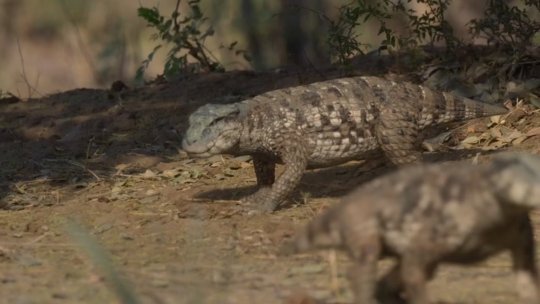
Obviously we didn't get much still, but I'll regardless post my list of candidates and ideas here, perhaps third time's the charme for a lot of these (tho for convenience I'm still ordering them by S2s episode titles). I'll also try to break them apart roughly by biome, starting with islands.
PS: I'd love to hear which crocs people would have loved to see themselves. Any on this list or stuff I didn't even mention? Let me know I'm curious.

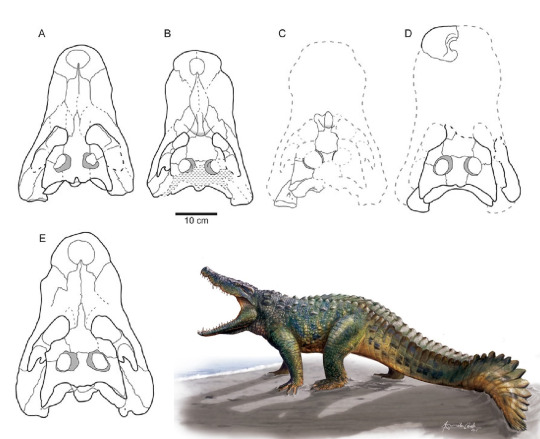

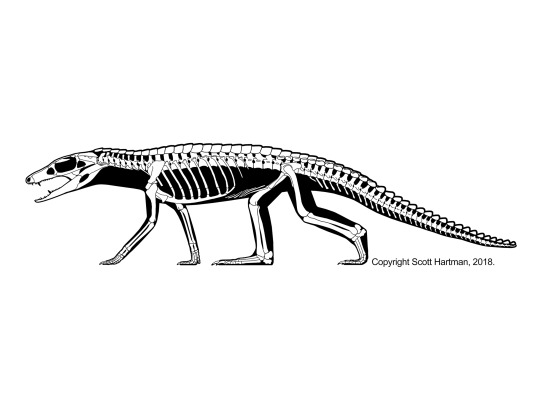

We got a shit ton of island crocs from the Cretaceous actually, which you can broadly divide into two categories.
The crocodiles of the European archipelago as seen in the top row.
Featuring the small, possibly shellfish eating Acynodon (art by Adramelech89), the incredibly widespread Allodaposuchus which did have some possibly semi-terrestrial forms (art by Alejandro Blanco, Aina and Agnès Amblás) and Aprosuchus, a tiny terrestrial critter from Hateg (art by @knuppitalism-with-ue). They already give a nice diversity between tiny durophages with blunt snouts, large, more traditional crocs and lanky land species.
The other island category concerns Madagascar, which had a lot of attention in season 2. Discounting Simosuchus, we got Araripesuchus tsangatsangana (art by Scott Hartman) and Mahajangasuchus (art by Mark Hallet). Both are really cool. The former is yet another smaller terrestrial species that may not actually be part of Araripesuchus, while the later is a massive, 4 meter relative of the famous Kaprosuchus that took to the water independently from all other crocs and has been nicknamed "Hippo croc" for its weird skull. Really I'd have loved to seen an episode entirely dedicated to this place.
Next up we had the badlands episode, which oh boy has a lot of contenders from the clade Notosuchia. Brace yourself.
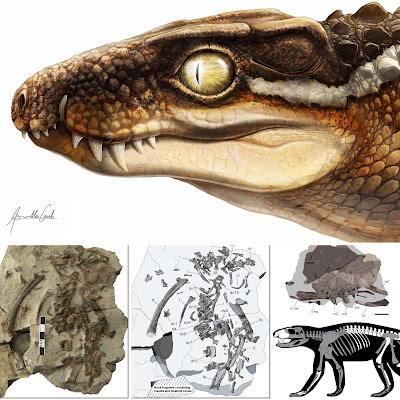


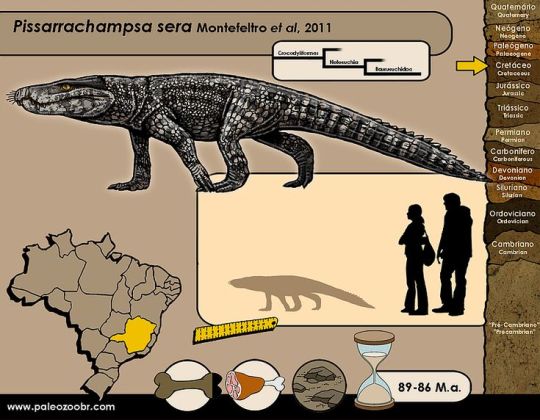


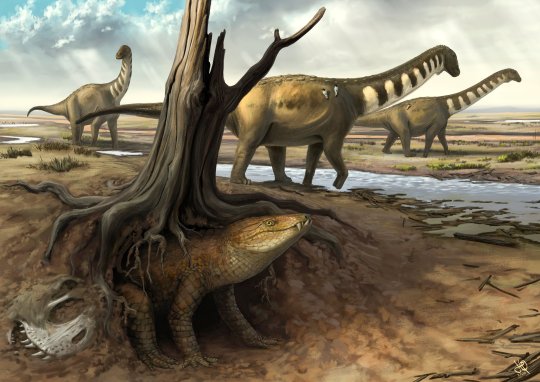

Here again I could split these in two categories.
The first is just general badland taxa. There's Ogresuchus for example, from Spain's Tremp Formation (art by Aina and Agnès Amblás). A relatively small sebecid found in a sauropod nesting site. And we all know what PhP does with baby sauropods. Or the long-necked Gobiosuchus (art by @yoofilos) from Mongolia, which may look like its related to the other ones in this category but actually is a far more ancient type of croc.
The far bigger group concerns South America's Notosuchians. ALL OF THESE are from the Bauru Group, with some even from the same single formation. You got Stratiotosuchus (again by Joschua Knüppe), a large terrestrial baurusuchid that filled the nische of mid sized carnivore in an environment shared by sauropods and abelisaurs. There's Pissarrachampsa (by Felipe Alves Elias), another baurusuchid I decided to feature because we have evidence of a nesting site that shows they only had few eggs. A great opportunity to show their tender side. Uberabasuchus (justin_an74), part of the bizzarly proportioned peirosaurids. Adamantinasuchus (by Deverson da Silva), a small, lanky Notosuchian and of course the heavily armored omnivore Armadillosuchus (by the ever talented Júlia d'Oliveira). Hell you could do a full episode just on the foodweb of the Bauru Group (Godoy et al. 2014).
Then there's swamps, which I'll just use to dump all the crocs that don't fit into the other categories.
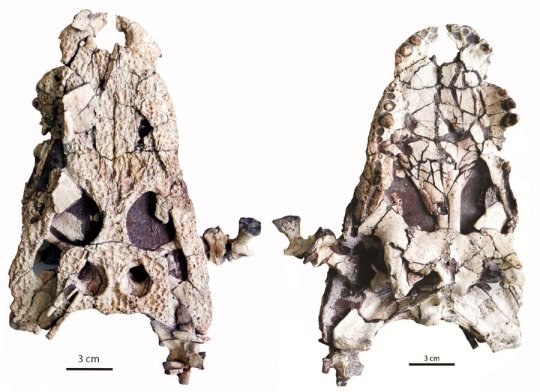


As you'd expect, freshwater would be ideal for crocs with a more traditional semi-aquatic lifestyle, here represented by three forms. Jiangxisuchus (image by Li et al. 2014) is a paralligatorid, which are tiny crocodilians from the Cretaceous and Paleogene of east Asia. We honestly don't know what they are, some say alligator relatives, others say they are closer to crocs. But its small and cute. Then there's Roxochampsa (artist of the model I couldn't find), which looks suspiciously crocodilian but is actually a relative of Uberabasuchus from the badlands, hell it appeared in the same formation. Still, I reasoned that I'd throw it into this category because I already proposed so much for badlands (none of which came true but hey). And then there's Denazinosuchus (art by Andrey Atuchin). Again it looks deceptively like a modern croc, but is actually the last remnant of the goniopholids, crocodyliforms that were prominent animals in the Jurassic and early Cretaceous. It could have brought both taxonomic diversity nad highlighted croc resilience till the end.
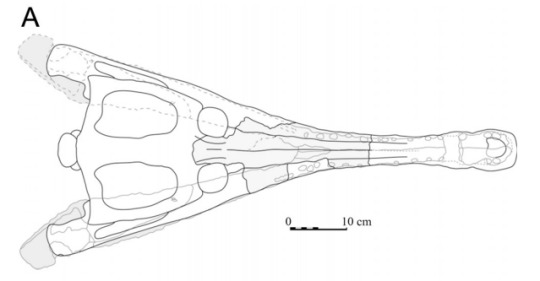

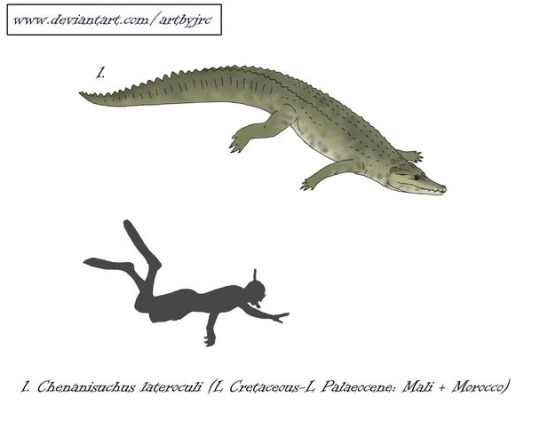
When it came to picking out crocs for Oceans, it got tricky. Obviously season 2 tried to differentiate itself by being set more in the open ocean, not the coast, and true pelagic crocodiles weren't around by the end of the Cretaceous. So I had to settle for coastal animals. There's Sabinosuchus (Schiller II et al. 2016), a cousin to Sarcosuchus and, like Denazinosuchus, one of the last of its lineage. Also its from Mexico which is rarely talked about for its fossils. Rhabdognathus (Ghedoghedo) is a distant cousin, a slender snouted dyrosaur. Unlike pholidosaurs, dyrosaurs actually did really well after the KPG impact and spread around a lot, living way into the Eocene. And finally Chenanisuchus (art by artbyjrc), which like Rhabdognathus was found both before and after the impact that killed the dinosaurs.

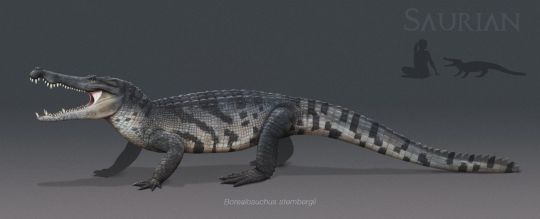
And the final two I shall talk about, both of which I thought/hoped would appear in the North America episode. Again, there's certainly overlap, both would have just as much fit into swamps, while many others would have also suited North America. Regardless, here's Brachychampsa (Tom Parker) and Borealosuchus (Chris Masna), both iconic animals from the Hell Creek Formation. One closely allied with alligators and caimans, the other more basal with a head-shape more similar to todays crocodiles.
Now obviously there'd have been a lot more. Part of the challenge to myself was to try and be as diverse as possible, rather than just listing 10 different baurusuchids I went with only two, tried to include as much of the world as possible, etc.... There's also the fact that some really awesome taxa, Titanochampsa, Brachiosuchus and Eurycephalosuchus, all incredibly unique or interesting, were published too late to have been considered for the show.
And now, in hinsight, we obviously know that with the exception of Simosuchus none of them made it in. Which is a shame, but maybe next time.
#prehistory#palaeblr#crocodile#paleontology#long post#prehistoric planet#prehistoric planet 2#borealosuchus#brachychampsa#simosuchus#pissarrachampsa#stratiotosuchus#gobiosuchus#ogresuchus#uberabasuchus#roxochampsa#armadillosuchus#adamantinasuchus#jiangxisuchus#denazinosuchus#sabinosuchus#rhabdognathus#chenanisuchus#mahajangasuchus#araripesuchus#acynodon#allodaposuchus#aprosuchus
159 notes
·
View notes
Text
While the Prehistoric Planet hype is still alive, I might as well express my desire for more and say what I'd personally love to see if they did a Season 3. I’ll put this under the cut because it’s a lot lol.
First thing's first, I'm going to be operating under the assumption we will be following the same format and setting, ie a few segments per episode set in the Masstrichtian stage of the Cretaceous with some loose overarching theme. I need to keep myself grounded in SOMETHING.
So first thing: I've already made fun of "North America" being the title of episode 2.5. What would fix this? If Season 3 did episodes centred on the other continents, of course! South America, Africa, Asia, Europe and... oh uh this might be a bit trickier. Specifically, where do Oceania and Antarctica go? Honestly, just do a vague "East Gondwana" episode for Madagascar, India, Antarctica and Zealandia.
"But we never saw anything from Appalachia!" True. Some generic "Islands 2" or "subcontinents" episode? But Antarctica isn't a subcontinent... maybe some "Atlantic" episode to combine with the European islands? Point is, it would still be messy. This isn't even my main idea, just a vague thought on how to structure Season 3 plus being salty that America gets its own episode (there weren't even any Canadian creatures lol).
OKAY enough fucking around, let's get to what I actually WANT to talk about, the stuff I'd actually want to see. Bring on the list!
Megaraptorids. We've seen representatives of all the large predatory theropods... except megaraptorids. A strange unique group of predators we don't even know where they fit in dinosaur cladistics, but seemed to be important in South American ecosystems. Orkoraptor actually comes from the same place as Dreadnoughtus so there's an easy excuse already, but I think it would be even more exciting to consider Maip. The size of this thing pretty much confirms they were apex predators, so definitely worth considering.
More notosuchians. It's wild how diverse they were, Simosuchus is just one of many species worth showing. Might as well mention Baurusuchids in particular, especially since they seem to have become significant predators in parts of South America. Dinosaur hunting crocs, guys.
Honestly? I'm down for crocodyliformes in general. Show us dyrosaurs in the seas, and even Eusuchians. Similar to modern crocs like Shamosuchus in Swamps, or something different like the more terrestrial Allodaposuchus.
More Europe weirdness! Whether it be Hateg fauna or stuff we know from other parts of the continent, I think people don't realise how unusual those ecosystems were, especially compared to Laurasia in general. Maybe I just want to see Magyarosaurus in detail, but also think about how Abelisaurs seem to be prominent terrestrial predators, for example? Also all the strange birds like Gargantuavis and maybe Balaur. Also, Asteriornis I see a lot of hype for. ;P
On a similar note, more stuff from Africa could be nice, especially terrestrial fauna! We know dinosaurs from Ouled Abdoun, which had fauna featured in Coasts and Deserts, and it's worth considering especially because you kind of see how some of these animals' ancestors may have led to similar species in nearby Europe. Also, if they ever further described more remains from the continent like that giant Kenyan abelisaur, that could provide cool opportunities.
This is a bit more out of left field but: non-ceratopsid ceratopsians. Leptoceratopsids, and even Protoceratopsids (hey, we have Velociraptor, we can make that stretch). Show how they're different from say Triceratops.
More non-hadrosaur ornithopods. Whether it be Thescelosaurus, more rhabdodontids, or some good ol Elasmarians from the Southern continents, I'd be down.
More India stuff is always fun, Deccan Traps FTW, could show other animals like noasaurs for that matter too.
Also Parankylosaurs, whether it be Stegouros with the macuahuitl, or an updated Antarctopelta (more Antarctica FTW).
Basically, even in terms of dinosaurs, show more stuff you've yet to do. Nodosaurs, Halzkaraptorines (again, see Velociraptor), heck even more of some groups we only briefly saw eg Alvarezsaurs and Pachycephalosaurs.
Honestly? More birds would be cool in general. I know we don't know much about a lot of them like Enantiornithines, but we could still try showing what we do know.
In terms of more familiar and recognisable stuff? I mean, you can't go wrong with well known species, but this is me wishing for stuff that's new. :P I will say though, if you want big names, we still haven't seen Ankylosaurus or Gallimimus...
Hmm, we haven't seen choristoderes, have we? In terms of other reptiles, not much comes to mind, nice we got to see Madtsoia in Islands at least.
Honestly more mammals could be fun. I'm pretty sure we have members of every modern group from the Maastrichtian somewhere (even monotremes, Patagorhynchus was recently described). Also diversity of lifestyles too.
Appalachia. More North America, but we see how life evolved somewhat differently on the eastern side of the continent and how it likely lacked some of the more recognisable animals we know from Laramidia.
I don't know enough about other groups to comment, so I'll leave it at that. Definitely got quite extensive, but honestly I'm all for exploring new places. Hell, look into invertebrates and fish I know heck all about (hmm I'm sure there's some cool sharks, right?).
Anyway, time to address the elephant in the room. What if the next season left the Maastrichtian, or we got a spin-off that did that? Well, I do have thoughts on that. For that, I could easily be SUPER biased and just name stuff that I personally want to see, but I think you'd need to think from the perspective of the higher ups too. In other words, what's gonna get the most eyes on the show? There's that, and also how well known the information of that time is, as well as considering things like cost and practicality. The Maastrichtian was chosen because it filled all three of those needs. You have iconic and charismatic species like T. rex, the Maastrichtian is very well studied and has sites from almost every continent, and because it's the closest to today, it's the easiest to film for.
I don't really know anything that would fit these three needs perfectly, ESPECIALLY in terms of filming locations (unless they wanna go majority CG, which I wouldn't mind personally but I know the production team likes real locations because of what they add to the show). But anyway, I have two possible eras as my main choices if they choose to do a similar kind of show: the Late Jurassic epoch (I'd name a specific stage but I don't know enough about them lol), and the Cenomanian stage at the start of the Late Cretaceous.
For the Late Jurassic (insert chosen stage of it here), you have a lot to work with. You have all the other most iconic traditional staple dinosaurs like Stegosaurus, Brontosaurus, Brachiosaurus and well known contemporaries like Diplodocus, Allosaurus, etc. In fact, the Morrison Formation is the main reason I opted for a Late Jurassic option. Sure, it does cover quite a bit of time, but we've seen Prehistoric Planet already take liberties with a six million year time span.
I think my main worry would be that some of the ecosystems on different continents might seem a bit similar, but honestly I doubt anyone would care too much. Plus, you have Asia with slightly different dinosaur groups, and Europe with their island ecosystems (eg Solnhofen). So even if it would be harder to film and some of the best locales for data are in more concentrated areas, I think there's enough to justify it. Also, novelty of early birds and birdlike dinos like Archaeopteryx.
As for the Cenomanian, you already have an easier time filming because angiosperms are now widespread, and you do have data from every continent. And while it doesn't have so many iconic species, there are a few, and some very charismatic animals to explore. Like, you have some of the biggest titanosaurs like Argentinosaurus. Massive Giganotosaurins who are built for hunting large sauropods. Everyone's favourite dinosaur, Spinosaurus. And again, stuff from almost every continent. Like, you could even have freaking Australia show up! Winton Formation is Cenomanian, so it could join the showcases of Africa, South America and others (I don't know so much about Cenomanian Laurasian fauna RIP). And while it would be true for the Late Jurassic as well, this time had especially peculiar nondinosaurs coexisting. Strange mammals. Giant freshwater fish. More unusual crocs. Even the earliest mosasaurs, all while ichthyosaurs and pliosaurs still existed. Basically, even if a layperson might only know Spinosaurus and Giganotosaurus from this time, you still have loads to potentially awe people with.
Anyway, that's a wrap on that. I have no clue what to expect for the future of Prehistoric Planet or what other upcoming palaeo docs will be like, but it's always fun to speculate!
16 notes
·
View notes
Text
Full Talent Swap NDRV3 Cast
Korekiyo: Ultimate Detective/Serial Killer
And so we find where the serial killer talent has gone! Groomed by his sister on stories of detectives and kidnapping for love, Korekiyo has become quite the skilled Detective.
Kiibo: Ultimate Anthropologist/Robot
Due to his intense need to understand humanity as a robot, Kiibo has become quite skilled at Anthropology
Chisa: Ultimate Aikido Master
Quick and strong, Chisa learned how to fight to help better help the people around her.
Nagisa: Ultimate Inventor
Always very smart and clever, Nagisa is a natural inventor with all that implies. Very determined to leave his impact on the world.
Mikan: Ultimate Artist
When no one would help her, Mikan turned to art to cope with her trauma. Eventually becoming fascinated with live performance pieces. Which she began to design her own based on her trauma, which where a huge hit. Though Mikan wonders if it's so popular because of its greater meaning, or because people just want to peep at her.
Great Gozu: Ultimate Child Caregiver
Yes he still wears the mask, children love it, dude seems really kind, and you need an energetic all in person to take care of little kids.
Peko - Ultimate Maid
She learned how to handle the household and clean for Fuyuhiko, clean also sometimes meaning murder, which her intense skills at got her noticed.
Koichi: Ultimate Tennis Player
Sometimes you're really good at tennis but you have addictive habits so you get a temporary banned from the league, oops.
Imposter: Magician
Sometimes you use magic to get money to survive, and get really good at it.
Naegi: Ultimate Supreme Leader
he’s a sweet boy who I could see amassing a following by sheer wholesomeness. His organization is a bunch of friends he made while wandering and they work together to improve their city and help people. While it started with simply getting food for people and the like, eventually this escalated to more reckless behaviors like prying up anti-homeless architects and organizing large protests. Naegi’s earnesty and need to help is leading him to being wanted as the mysterious organizer of large scale protests and routine defiance of cruel laws. The group has swelled to a shocking size but Naegi still considers it just a group of friends trying to do what is right. He wears a green ushanka he got as a gift, both a very welcoming hat and a hat used in war, fits him. Can you tell he's my favorite in this au?
Ryota: Ultimate Cosplayer
Still inspired by animation, Ryota tried to escape himself by becoming the characters he saw on tv.
Chihiro: Ultimate Astronaut
I know they were originally the Tennis Player but with their subtle love for the stars you can see in their room, I felt Chihiro could make a great astronaut.
Hifumi - Ultimate Entomologist
I still think Hifumi making weird bug gjinkas is funny and that's my only reason.
Yasuhiro: Ultimate Adventurer
Yasuhiro has done some crazy things to escape the mafia like hiding in caves and drinking mud, and has even been to south america, I think he's earned the title
Kyosuke: Ultimate Pianist
He's just got stuck up pianist energy.
Kaede: Ultimate Assassin
Since Kiibo is also the Ultimate Robot and I've seen some great assassin stuff, Kaede is the Ultimate Assassin, but she likely words it like "oh yeah I'm the Ultimate Cleaner" or something. Very motivated to help people, even if it means she has to hurt people for it.
#full talent swap au#ndrv3#kaede akamatsu#yasuhiro hagakure#kyosuke munakata#hifumi yamada#chihiro fujisaki#Ryota Mitarai#makoto naegi#ultimate imposter#peko pekoyama#great gozu#mikan tsumuki#Nagisa Shingetsu#Chisa Yukizome#kiibo#k1-b0#korekiyo shinguuji#musings from the music manager
35 notes
·
View notes
Text
Far-right outsider Javier Milei wins Argentina’s presidency
Javier Milei has won Argentina’s presidential elections in provisional results, wrenching his country to the right with a bombastic anti-establishment campaign that drew comparisons to that of former US President Donald Trump – all against the backdrop of one of the world’s highest inflation rates.
His rival Sergio Massa conceded the run-off vote on Sunday evening in a brief speech even before official results were announced. “Milei is the president elected for the next 4 years,” said Massa, adding that he had already called Milei to congratulate him.
...
Milei’s victory marks an extraordinary rise for the former TV pundit, who entered the race as a political outsider on a promise to “break up with the status quo” – exemplified by Sergio Massa.
His campaign promise to dollarize Argentina, if enacted, is expected to thrust the country into new territory: no country of Argentina’s size has previously turned over the reins of its own monetary policy to Washington decisionmakers.
Milei, a social conservative with ties to the American right, opposes abortion rights and has called climate change a “lie of socialism.” He has promised to slash government spending by closing Argentina’s ministries of culture, education, and diversity, and by eliminating public subsidies.
“Make Argentina great again!” Trump posted on his platform Truth Social Sunday, in reaction to Milei’s win. “I am very proud of you,” he wrote.
Similarities to Trump have not gone unnoticed in the United States as it prepares for its own presidential elections. Milei succeeded in attracting attention at home not only because of his political style – including wielding chainsaws and raging outbursts – but also because of the novelty of his positions and eagerness to upset the status quo.
Echoing the Trumpian slogan, ‘Drain the swamp’, Milei’s supporters shout “¡¡Qué se vayan todos!!” which translates as “May they all leave!” – an expression of fury at politicians from both sides of the spectrum. Argentina’s left is currently in government, following rule by the right from 2015 to 2019.
Outside of his controversial plan for dollarization, Milei’s political program includes slashing regulations on gun control and transferring authority over the penitentiary system from civilians to the military; both measures part of a tough-on-crime approach. He proposes using public funds to support families who choose to educate their children privately and even privatizing the health sector, which in Argentina has always been in public hands.
Several outspoken comments landed Milei in hot water, without deterring his most ardent supporters. He triggered an uproar when it appeared Milei was in favor of opening a market for organ transplants, although he later retracted his declarations. He was similarly forced to apologize after calling Pope Francis, who is from Argentina and is seen as an icon of progressive politics in South America, “an envoy of Satan” in 2017.
5 notes
·
View notes
Text
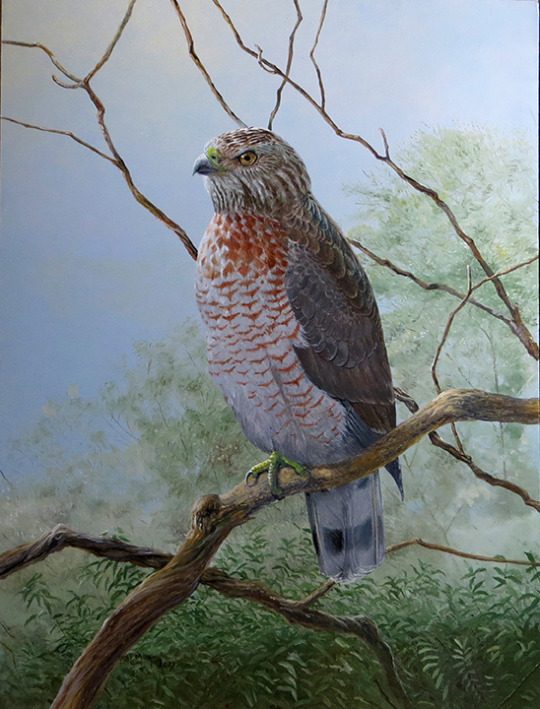
The Broad-winged Hawk (Buteo platypterus) breeds throughout most of temperate and the more southern parts of the boreal regions of North America, as well as in the West Indies, where there are five different island or archipelago-specific subspecies, all endemic and non-migratory. Northern birds winter as far south as central South America. In fact, the northern birds are noteworthy here in Ontario and much of eastern North America for their spectacular southward migration – that is, if you know when and where to look. Massive numbers can pass by in a single day in the autumn, but usually (not always) rather high up, slowly circling, wings outspread, to catch thermals, or updrafts, that allow them to fly with minimum energy expenditure. Updrafts are like large bubbles of rising, warmer air. The birds start near the top and circle around the invisible bubble. Actually they are going down as the air goes up, so they may rise, slowly descend or stay at a pretty much the same altitude until reaching the bottom of the bubble at which point they soar to the next one. While they obviously detect the upward movement of warmed air they also know where such thermals are by seeing other hawks, eagles and vultures taking advantage of them. Thus, they actually fly many times further than the distance they cover from start to end, but with far less energy used than if they went “as the crow flies” in a straight line.
I have had people tell me they have never seen a Broad-winged Hawk on days and in places where I have seen hundreds. One has to be attune to looking for them, and a good pair of binoculars certainly helps to enjoy the sight.
These flocks, some numbering in the thousands, may include various other birds of prey, including other members of the genus, Buteo, all having broad wings and rounded tails, along with other birds of prey, and vultures. It can be fun to try to identify the various species, and keeping track of numbers over the years is an important “citizen science” project that can determine trends in population sizes. Such “hawk watches” can turn into enjoyable social gatherings in places where the topography enhances the occurrence of updrafts, such as Hawk Cliff, Lake Erie, here in Ontario, Hawk Mountain, in Pennsylvania, Hawk Ridge in Minnesota and the River of Raptors in Mexico.
These are smallish, chunky hawks with relatively short tails. I have shown an adult, which is somewhat barred underneath, with the bars tending to coalesce across the upper breast, although typical of hawks, there is a great deal of individual variation. Immature birds are streaked on the breast and can be a little tricky to distinguish from the young of other members of the genus, Buteo. Broad-wing adults weigh about 265 to 560 grams, or approximately 9.3 to nearly 20 ounces. Most are light morphs, but there is a rare dark morph that can be an all-over dark sooty-chocolate brownish color but with the same underwing and tail patterning as the typical pale morph.
Food consists of pretty well any small vertebrates they can capture, as well as large invertebrates, including insects, worms, and crabs, but small mammals, birds, reptiles and amphibians make up most of the diet. Driving through “cottage country”, in the Precambrian shield country of central Ontario, this hawk can often be seen perched on telephone wires, along the road’s edge, patiently waiting for prey. This painting is approximately life-size in oils on a birch panel. I have also included a small preliminary study I did very many years ago, in acrylics on illustration board.

art may be used for non-commercial purposes with attribution
prints and original art for sale on Fine Art America
support barry kent mackay on ko-fi
17 notes
·
View notes